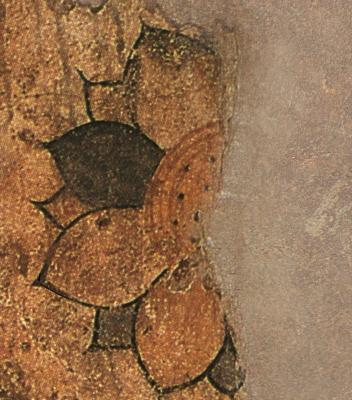- Koguryo and Balhae
- Susahn-ri Tomb
Koguryo and Balhae
| Title | Eastern Wall of the Main Chamber - Lotus Pattern | ||
|---|---|---|---|
This is a detailed view of the lotus pattern depicted on the eastern wall of the main chamber in Susahn-ri Tomb. The lotus is a flower that grows beautifully from the mud of a pond and symbolizes purification and rebirth in Buddhism. In other words, the muddy pond symbolizes the secular world, and the blooming lotus represents purity and reincarnation in the Buddhist Land of Bliss. In Buddhism, the Sukhavati Rebirth (reborn in the Land of Bliss) was generally represented with paintings of figures appearing inside blooming lotuses referred to as the lotus transformation motif.
Judging by the northern wall, the lotus pattern in the image would have been depicted symmetrically on either side of the lambda-shaped (Λ) truss between the primary and secondary joists. Only a small section of the lotus is now visible, and the lotus on the right has been completely lost due to deterioration. The lotus features two layers of eight petals in a two-tier configuration. The circular beads that appear to be stigmas can be seen on top of the central seedpod surrounded by two layers of petals. The petals in the top layer are elliptical while the bottom layer features petals with sharp, pointed ends. The petals in the top layer are rendered in a black and white two-tone configuration.
The depiction of lotuses near the ceiling of the chamber is indicative of the Buddhist view of the spiritual world held by the entombed as well as the Koguryo people's desires for a Sukhavati Rebirth (reborn in the Land of Bliss).








